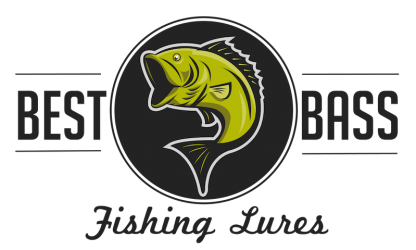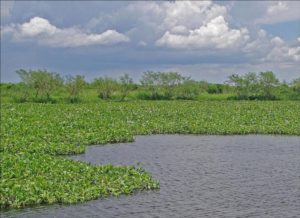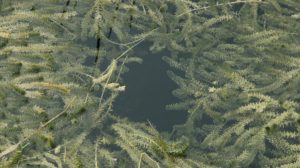
Punching for bass is one of the best techniques for triggering big bass to bite. It’s also a great method to use when conventional fishing is not producing. There are times when a lot of bass will be buried up in thick vegetation, and using a punch rig is one of the only ways to pull them out of there.
Before we dive, or should I say “punch”, in to this style of fishing, let’s talk about what the term “punching” means. For those who don’t know, the bass fishing definition of the word punching is the action of plunging a lure through thick surface weeds to get it to the bass hiding below. Underneath surface weeds are very desirable areas for fish to hide, so getting your bait in there can be extremely rewarding.
There are a few different styles of punch rigs, but if you want to checkout a pretty unique punching jig then check out the BiCO BoMB. This one ounce punch jig blasts through vegetation better than any other punch jig because of its hydrodynamic profile.
Here’s a really informative video of the creator of the bait fishing some matted vegetation with it. He also recently created a half-ounce version of the jig called the BiCO Bullet, designed for lighter vegetation.
Contents
Best Punch Rigs
So what is a punch rig? A punch rig is basically a bait that is specifically designed to get through thick surface vegetation to present itself to the fish below. The key is to use the lightest weight you can get away with that will get through the weeds efficiently. There are three main types of punch rigs so lets take a look at each one.
Creature Baits Texas Rigged
This consists of a soft plastic creature bait that is Texas rigged with a strong hook and heavy bullet style weight. These weights are usually made of tungsten and often referred to as flipping weights.
They will typically be in the three-quarter to sometimes as much as two ounce range. The weight you choose is determined by how thick the weeds are that you are punching.
Punch Jigs
These are much heavier than standard bass jigs, usually weighing in the ounce or more range. These jigs will typically have a bullet shaped head that allows the jig to penetrate through vegetation better.
The weedguard on these jigs will be at sharper angler than on conventional jigs, giving them a more compact design to get through the weeds easier. Like with most bass jigs, they are usually rigged up with a soft plastic trailer. If you’re looking for a good punch jig check out the BiCO BoMB.
Punch Skirts
Punch skirts are popular because they are similar to a punch jig but with a straighter profile. This helps this style rig get through the vegetation easier than a punch jig, while still getting the action from a skirt. When the bait hits the bottom, the skirt will flair out giving it a nice presentation. Punch skirt rigs are also paired up with a soft plastic trailer.
Punching Mats
You will often hear bass fishermen talking about “punching mats” or “grass mats” or “matted vegetation.” When anglers are talking about mats, they are referring to any kind of surface vegetation that has open water under it. Those are the two components that make up a good mat for punching.
They can come and go as the seasons change, and will at times provide a better source of cover for fish than other times. It really depends on where you are located and the kind of vegetation that is growing in that particular body of water.
Sometimes you can find weeds like hydrilla that grow so long that they folds over and lay flat on the surface, or even a thick patch of lily pads. Of course not all bodies of water provide good punching vegetation, so do your homework before heading out.
Some mats are created when weeds die and break off from the bottom and float to the surface. Then wind or current will push the weeds together against something somewhat stationary in the water like the water’s edge, a weed line, a patch of lily pads, a tree in the water, etc. The floating weeds keep building up and create a very nice mat for punching.
Bass love sitting under thick mats of vegetation, especially when there are nice defined edges with open water abutting it. Bass will use these areas for hiding in and ambushing prey like baitfish and crayfish. They also provide protection from sunlight, a bass’s eyes don’t adjust to the sunlight like ours do so they are always looking for shade on bright sunny days.
Flipping and Pitching Punch Rigs
Punching is done with a very popular technique called flipping and pitching. This a style of fishing used when you are fishing very close to the cover you are targeting, and by close I mean usually less than ten feet. When you approach a target that you want to flip or pitch a punch rig to, you want to get close enough that you can comfortably get your bait to quietly get in to the vegetation. Because you are fishing so close to the bass within, remaining as stealth as possible is very important.
With that said, bass feel very safe in thick vegetation, and that’s why you are able to get so close. The main reason is because they can’t see you, but any loud and/or unnatural noises can quickly turn a great looking area in to a dead zone. One of the biggest causes of this is the weight hitting the side of the boat upon the retrieve. When you are pulling your bait out of the weeds, its important not to load up pressure on the rod if it gets hung up because if the bait suddenly springs loose it can come back at you very fast and smash the side of the boat. A sound like this will quickly spook surrounding bass, and weary bass aren’t interested in eating.
Once you flip or pitch in to the vegetation, the goal is to have the punch rig sink to the bottom as fast as possible. This fast sinking action is what can cause a reaction strike, and the reason why punching catches huge fish. The bass don’t have time to inspect the bait, they just react to the motion and attack it before it hits the bottom. A good amount of strikes will happen this way so you need to be in a position to set the hook the second that bait hits the water.
If the punch rig hits the bottom without getting hit, let it sit for a few seconds then pop it up from the bottom and sink back down. You should pop it up and down like this a few times before reeling it back in and flipping to a different spot in the vegetation. Flipping punch rigs is pretty much repeating this process over and over again.
It’s important to be thorough when working a mat of vegetation by punching the bait through in many different sections. Because you don’t know what the weeds look like under the mat, the bass might not be seeing the bait in certain areas even if it’s only a few feet away. It’s not uncommon to punch a bait in one spot and not get bit, then punch two feet to the right and then get bit.
Throwing these heavy baits and horsing fish out of thick weeds requires a heavy duty setup. For more information on selecting the best punching rod for this style of fishing click that link. On that page we go over all the gear required for fishing punch rigs.





